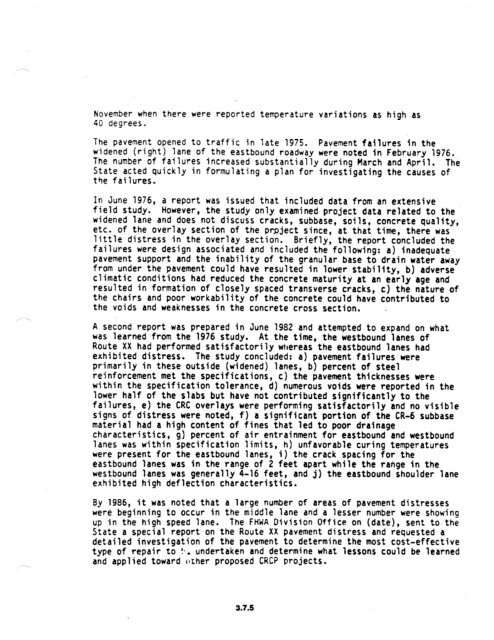chapter 3 rigid pavement - DOT On-Line Publications - Department ...
chapter 3 rigid pavement - DOT On-Line Publications - Department ...
chapter 3 rigid pavement - DOT On-Line Publications - Department ...
You also want an ePaper? Increase the reach of your titles
YUMPU automatically turns print PDFs into web optimized ePapers that Google loves.
November when there were reported temperature variations as high as<br />
40 degrees.<br />
The <strong>pavement</strong> opened to traffic in late 1975. Pavement failures in the<br />
widened (right) lane of the eastbound roadway were noted in February 1976.<br />
The number of failures increased substantially during March and April. The<br />
State acted quickly in formulating a plan for investigating the causes of<br />
the failures.<br />
In June 1976, a report was issued that included data from an extensive<br />
field study. However, the study only examined project data related to the<br />
widened lane and does not discuss cracks, subbase, soils, concrete quality,<br />
etc. of the overlay section of the project since, at that time, there was<br />
little distress in the overlay section.' Briefly, the report concluded the<br />
failures were design associated and included the following: a) inadequate<br />
<strong>pavement</strong> support and the inability of the granular base to drain water away<br />
from under the <strong>pavement</strong> could have resulted in lower stability, b) adverse<br />
climatic conditions had reduced the concrete maturity at an early age and<br />
resulted in formation of closely spaced transverse cracks, c) the nature of<br />
the chairs and poor workability of the concrete could have contributed to<br />
the voids and weaknesses in the concrete cross section. .<br />
A second report was prepared in June 1982 and attempted to expand on what<br />
was learned from the 1976 study. At the time, the westbound lanes of<br />
Route XX had performed satisfactorily whereas the eastbound lanes had<br />
exhibited distress. The study concluded: a) <strong>pavement</strong> failures were<br />
primarily in these outside (widened) lanes, b) percent of steel<br />
reinforcement met the specifications, c) the <strong>pavement</strong> thicknesses were<br />
within the specification tolerance, d) numerous voids were reported in the<br />
lower half of the slabs but have not contributed significantly to the<br />
failures, e) the CRC overlays were performing satisfactorily and no visibie<br />
signs of distress were noted, f) a significant portion of the CR-6 subbase<br />
material had a high content of fines that led to poor drainage<br />
characteristics, g) percent of air entrainment for eastbound and westbound<br />
lanes was within specification limits, h) unfavorable curing temperatures<br />
were present for the eastbound lanes, i) the crack spacing for the<br />
eastbound lanes was in the range of 2 feet apart while the range in the<br />
westbound lanes was generally 4-16 feet, and j) the eastbound shoulder lane<br />
exhibited high deflection characteristics.<br />
By 1986, it was noted that a large number of areas of <strong>pavement</strong> distresses<br />
were beginning to occur in the middle lane and a lesser number were showing<br />
up in the high speed lane. The FHWA Division Office on (date), sent to.the<br />
State a special report on the Route XX <strong>pavement</strong> distress and requested a<br />
detailed investigation of the <strong>pavement</strong> to determine the most cost-effective<br />
type of repair to !‘* undertaken and determine what lessons could be learned<br />
and applied toward IIther proposed CRCP projects.<br />
3.7.5
















